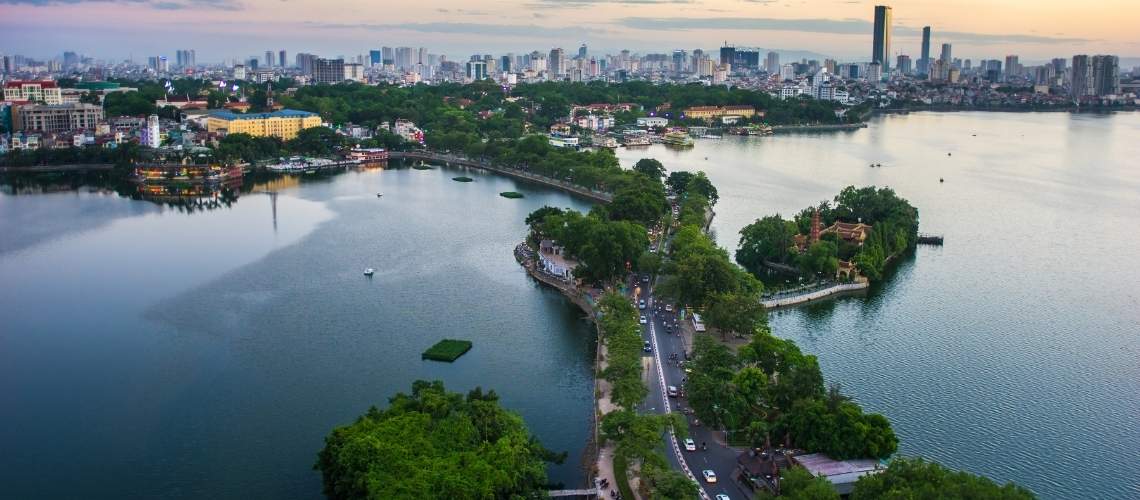Hanoi, the bustling capital of Vietnam, offers a wide variety of housing options— from budget-friendly studio apartments to spacious serviced residences in modern complexes. This guide will help you understand the local rental market, the most popular districts, and how to navigate the process of renting a property in Hanoi.
1. Understanding the Hanoi Rental Market
- Wide Range of Prices and Quality
You can find small studios in older buildings for under US$300 per month in some neighborhoods.
Modern serviced apartments in central areas or newly developed districts can cost anywhere from US$500 to over US$2,000 per month, depending on size, location, and amenities.
Traditional Houses (Nhà ống): Narrow, tube-shaped homes common in Vietnam’s major cities, sometimes spanning multiple floors.
Apartments: High-rise and mid-rise developments with varying levels of security and shared amenities (like gyms or pools).
Serviced Apartments: Usually fully furnished with weekly housekeeping, laundry services, and building management.
Villas or Townhouses: Larger properties often found in gated communities or expat-focused neighborhoods, typically more expensive.
- Rental Agreements & Lease Terms
Lease lengths can range from six months to two years. Many expats negotiate one-year leases with a security deposit (usually one to three months’ rent).
Utility bills (electricity, water, internet) are sometimes included in serviced apartments, but typically tenants pay these separately in other rentals.
Maintenance and minor repairs are typically the landlord’s responsibility, but clarify this in the contract.
2. Popular Neighborhoods for Renters
Home to a large expat community, scenic lake views, and plenty of cafés and restaurants.
Budget: Mid-range to high-end (US$400 – US$2,000+).
Pros: International vibe, good dining options, and relatively peaceful environment.
Cons: Less “local” feel, can be pricier than other areas.
- Hoàn Kiếm (Old Quarter & Central Hanoi)
The historic center with proximity to Hoàn Kiếm Lake, cultural sites, and nightlife.
Budget: Medium to high (US$500 – US$1,500+).
Pros: Very central, lots of entertainment, restaurants, and easy transport access.
Cons: Busy, noisy, and congested streets; older buildings.
Government buildings, embassies, and offices. Known for wide boulevards and green spaces.
Budget: Mid-range to high (US$400 – US$1,500+).
Pros: Central location, quieter than the Old Quarter, and historically significant sites.
Cons: Limited high-rise options; older housing stock.
Rapidly developing districts with many modern apartment complexes, international schools, and business offices.
Budget: Wide range (US$300 – US$1,500).
Pros: Newer buildings with modern amenities, close to technology and business parks.
Cons: Farther from the historic center; commute traffic can be heavy.
Known for universities, hospitals, and large shopping centers like Vincom.
Budget: Mid-range (US$300 – US$1,000+).
Pros: Mix of local life and newer developments; good public transport links.
Cons: Busy, traffic congestion during peak hours.
3. How to Search for Rental Properties
- Real Estate Websites & Apps
Batdongsan.com.vn: One of Vietnam’s largest property portals (in Vietnamese but with optional English-language sections or Google Translate).
Muabannhadat.vn: Another major listing site.
Facebook Groups: Numerous expat or housing-focused groups, such as “Hanoi Massive” or “Hanoi Housing, Apartments & Expats.”
Zalo & ChoTot: Popular local apps/platforms for buying, selling, and renting properties.
Agents often specialize in particular districts or neighborhoods. They may speak English or partner with an English-speaking colleague.
Ask about any service fees upfront—sometimes the landlord covers the agent’s commission, sometimes the tenant does, or it may be split.
- Word-of-Mouth & Local Connections
Ask friends, colleagues, or other expats for recommendations. Landlords often prefer to rent to someone with a personal connection.
Getting referrals can help you find better deals and avoid scams.
4. Evaluating and Viewing Properties
Compile a list of “must-have” criteria (budget, location, size, furnishing, proximity to work or schools).
Verify what is included (furniture, kitchen equipment, bedding, etc.).
Look at street traffic, noise levels, and any potential construction projects nearby.
In older areas, confirm the building’s condition (e.g., water pressure, elevator maintenance).
Who pays for utilities and how are they billed (some older buildings may not have separate meters)?
Is internet service and cable TV included?
How many sets of keys are provided?
Is there 24-hour security or a doorman (especially in apartment buildings)?
Mold, leaks, pests, and poor ventilation are common issues in humid Hanoi.
Electrical wiring—especially in older buildings—should be checked for safety.
Test the water pressure and hot water system if possible.
5. Negotiating and Finalizing the Lease
Monthly rent is often negotiable. Politely propose your counteroffer if the initial price is higher than average for the area.
Ask to include basic maintenance or small repairs in the rent if that’s not already specified.
If staying longer than a year, discuss a discount or fixed rate for the contract duration.
- Lease Contract Essentials
Deposit Amount: Usually one or two months’ rent, sometimes three if it is a high-value property.
Renewal Clause: Clarify how and when you can renew or extend the lease, and if the rent can increase.
Early Termination: If you need flexibility, discuss potential penalties and notice periods.
Most landlords accept monthly rent in cash (Vietnamese Đồng), though some may accept bank transfers.
Keep receipts or proof of payment (screenshots, signed notes) for future reference.
- Legalization & Registration
Upon moving in, your landlord should register your tenancy with local authorities. This is a standard procedure in Vietnam.
If you are a foreigner, ensure you have valid visas or residence cards; some landlords will ask for this documentation.
6. Practical Tips for Living in Hanoi
Electricity: Billed monthly, with escalating tariff rates if usage is high.
Water: Typically inexpensive, but in older buildings, verify the water quality and pressure.
Internet & Cable: Fast fiber connections are widely available. Expect around US$10–$15 per month for a mid-range internet plan.
Motorbikes are the most common mode of transport; you can rent or buy one fairly easily.
Taxis and ride-hailing apps (Grab, Be, GoJek) are common and affordable.
If you choose a neighborhood far from your workplace or school, factor in traffic congestion during rush hours.
Basic Vietnamese phrases can help with daily transactions (paying bills, shopping at local markets).
Many younger Vietnamese speak English, especially in expat-friendly areas, but in less touristy parts of town, English can be limited.
- Local Community & Culture
Respect local customs, especially in traditional neighborhoods (noise levels, dress codes, etc.).
Many expat groups organize events, making it easier to make friends and integrate.
7. Common Pitfalls and How to Avoid Them
Beware of deals that are “too good to be true,” especially listings with no proper address or limited photos.
Always view the property in person before handing over any deposit.
- Over-Priced Expat Rentals
Certain landlords may inflate rents for foreign tenants. Research comparable listings in the same area to gauge fair pricing.
- Lack of Written Agreement
Always insist on a written lease/contract, in both English and Vietnamese if possible.
Verbal agreements can lead to misunderstandings about rent, deposits, and responsibilities.
Clarify in writing which utilities and services are included.
Ask about building maintenance fees, shared services, parking, or management fees.
Finding a suitable rental in Hanoi can be relatively straightforward once you’re equipped with the right information. By identifying your budget and preferred district, utilizing reputable real estate platforms, and carefully reviewing contracts, you can enjoy a comfortable stay in Vietnam’s historic capital. Whether you choose the lake views of Tây Hồ or the energetic streets of the Old Quarter, Hanoi offers a unique blend of modern conveniences and timeless charm. Good luck with your search—and welcome to the city!







 Compare (0)
Compare (0)